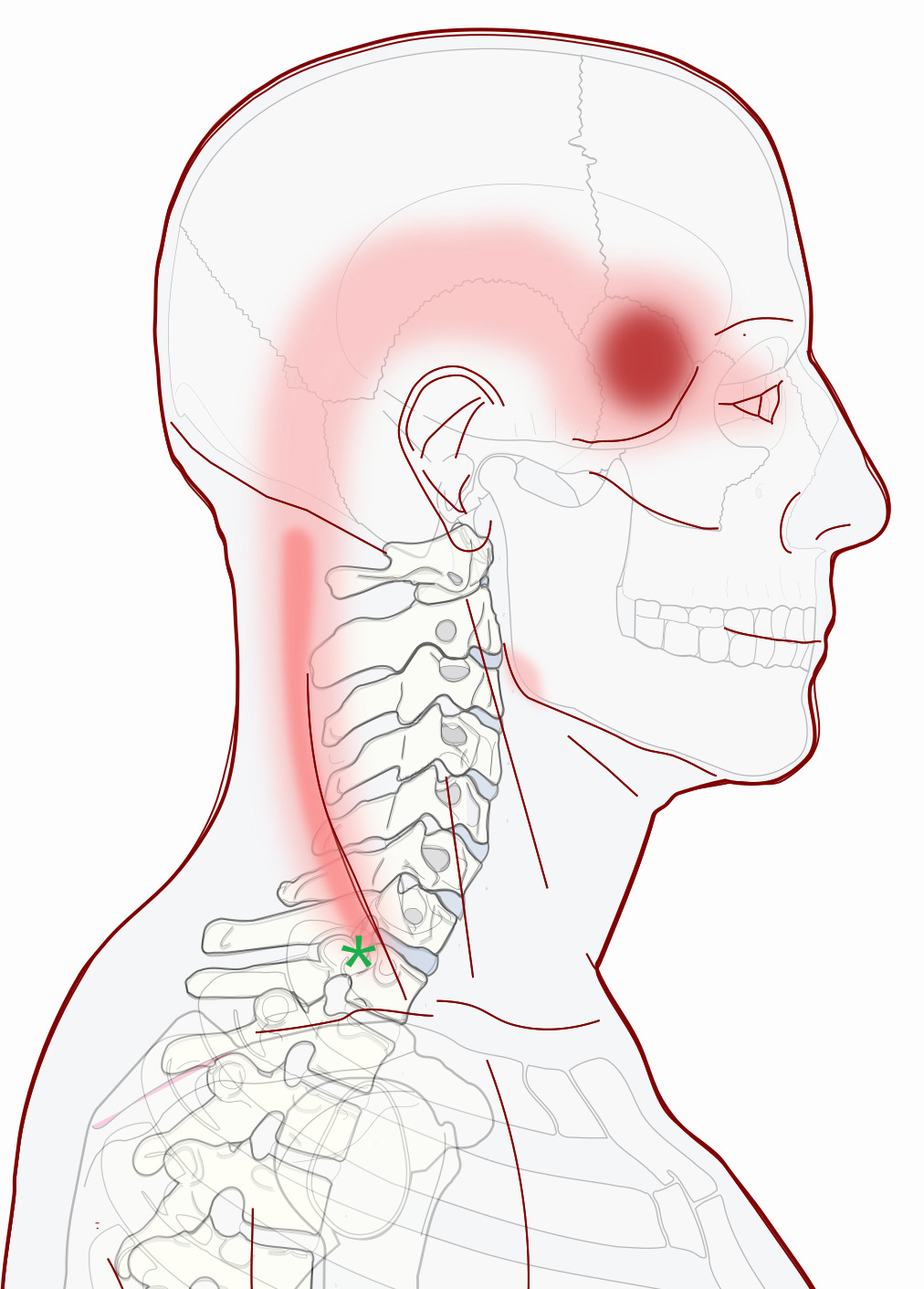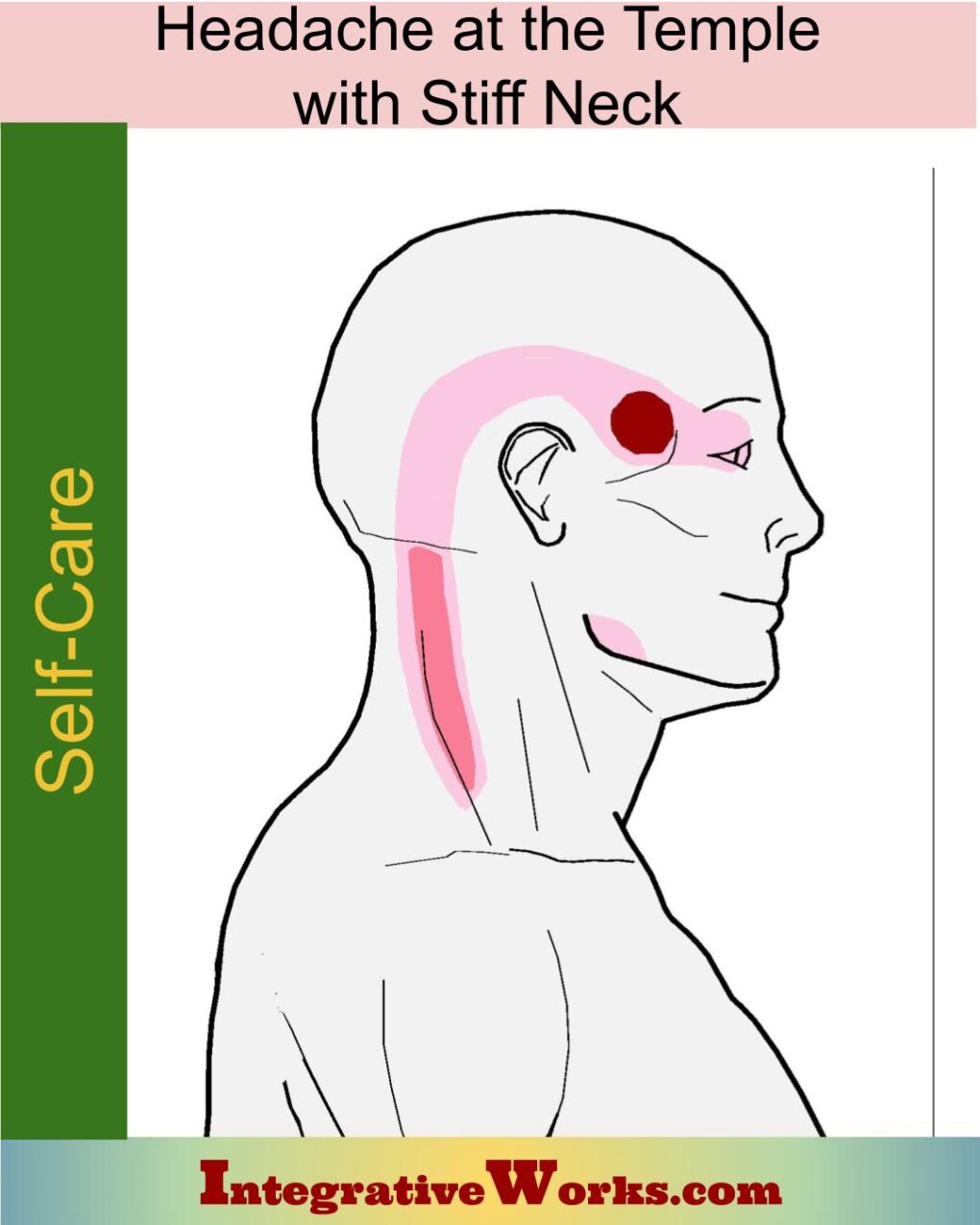Table of Contents
- How People Describe This Pain Pattern
- How You Activate and Intensify This Pain Pattern
- Self-Care – Getting Relief on Your Own
- Musculoskeletal Anatomy Behind Your Pain
- Therapy Notes for Massage and Bodywork
How People Describe This Pain Pattern

People touch their temple and say, “I have a headache right here.” When I ask them for other things that bother them, they usually complain of a stiff neck. It is also common that they trace from the neck around the back of the ear to the temple. When asked about their eyes, they often have tension from this headache.
Jaw Pain
Occasionally, they speak of jaw pain. This usually only happens with clients that are very sensitive to their head pain or have had previous TMJ dysfunction.
The shoulder is weaker when they hold the phone with the shoulder. The shoulder tires quickly and intensifies your headache. They may shift to the other shoulder but find it aggravates the stiff neck. There have been fewer complaints as speakerphone, and earbud usage has increased.
Shoulder Problem
Actually, this headache is a shoulder problem. If you’ve had problems in your shoulder, especially something that has pulled down or jerked the shoulder, the problem probably comes from there. Once the joints of the clavicle, especially the acromioclavicular joint, become stiff or mildly separated, this part of the trapezius develops trigger points and resists stretching.
Often, the pattern hurts when you get up after sitting with your shoulders shrugged. The shoulder also seems tight when you lean away, as when you hold your phone on the other shoulder. This stretching motion, especially when the trigger point is very active, will increase a headache or make the stiff neck agitated.
I’ve watched people in meetings rub their neck and shoulder while leaning forward, reading. In this case, the pain along the shoulder slope is active, and they don’t notice the headache as much. They are surprised and amazed when I ask if they have tension around the back of their ear or tension in their temple.
How You Activate and Intensify This Pain Pattern

Sudden Jerk on Shoulder
This trigger point can be activated when something yanks down on the shoulder. Clients often return more than once because their dog has taken off suddenly. I was able to stop my dog from doing this with ideas from a video on YouTube called “Command Performance.”
I’ve had many Do-it-Yourselfers, weekend warriors, and backyard mechanics that have hurt this with a sudden overload of the shoulder. This jerk on the shoulder creates a bind, or sometimes, a mild separation in the shoulder joint, and the problem persists until a bodyworker, orthopedist, or surgeon works on it. When this happens, they may only complain of a stiff neck, especially if they have Forward-Head Posture. If both shoulders get mild joint problems, the neck tends to be stiff when turned in either direction.
Seated Elbow Support
This part of the trapezius will stretch as your shoulder drops when you get up from the desk, and the headache will worsen as the trapezius supports the weight of the shoulder. A lot has been written about getting chairs with the right armrest instead of dealing with the underlying problem so that the trapezius shortens and lengthens comfortably.
Mild Shoulder Separtion
Once the joints of the clavicle, especially the acromioclavicular joint, becomes stiff or mildly separated, this part of the trapezius resists stretching. Often, the pattern hurts when you get up after you have been sitting with your shoulders shrugged. The shoulder also seems tight when you lean away, as when you hold your phone on the other shoulder. This stretching motion, especially when the trigger point is very active, will increase a headache or make the stiff neck agitated
The Musculoskeletal Anatomy Behind Your Pain
Musculoskeletal Anatomy
This post on anatomy contains standard information about the origin, insertion, function, and innervation of muscles. Additionally, it includes information on functional considerations and anomalies.
Find Related Posts
Anatomy posts have a grid of all related posts. This includes posts on pain patterns, self-care, therapy notes, NMT protocols, cranial techniques, and cases.
Getting Relief on Your Own
Clinically Proven
Self-Care Strategies
Self-Care Posts have common sections to make them easy to follow and understand:
- Activities to Avoid or Change
- Strategies for Quick Relief
- Stretches and Exercise for Longer-Lasting Relief
- Yoga Corner
Therapy Notes for Massage and Bodywork
Better Bodywork
Through Shared Expertise
Therapy Notes provide details for cranial, spinal, and local joint work. These notes also link to a traditional neuromuscular protocol.
By treating integrative components first, direct work on the muscle becomes less intense while providing longer-lasting relief.
Support Integrative Works to
stay independent
and produce great content.
You can subscribe to our community on Patreon. You will get links to free content and access to exclusive content not seen on this site. In addition, we will be posting anatomy illustrations, treatment notes, and sections from our manuals not found on this site. Thank you so much for being so supportive.
Cranio Cradle Cup
This mug has classic, colorful illustrations of the craniosacral system and vault hold #3. It makes a great gift and conversation piece.
Tony Preston has a practice in Atlanta, Georgia, where he sees clients. He has written materials and instructed classes since the mid-90s. This includes anatomy, trigger points, cranial, and neuromuscular.
Question? Comment? Typo?
integrativeworks@gmail.com
Interested in a session with Tony?
Call 404-226-1363
Follow us on Instagram

*This site is undergoing significant changes. We are reformatting and expanding the posts to make them easier to read. The result will also be more accessible and include more patterns with better self-care. Meanwhile, there may be formatting, content presentation, and readability inconsistencies. Until we get older posts updated, please excuse our mess.





Comments are closed.